Airports in the Americas are taking a greater interest in the wellbeing of passengers and staff, addressing everything from air quality to stress levels, reports Chris Anderson.
Whenever we travel via an airport, our minds are perhaps more occupied with the environment awaiting us at our destination, rather than the one we are temporarily passing through. A beach holiday promises sand and sea, while a ski trip offers snow and mountain air – plenty to get excited about. By comparison, an airport will offer passport checks, customs, departure gates and shops, and potential crowding or queues.
However, there are lots of airports that are starting to become more mindful of the environment they present to passengers, and also to their staff, who may occupy it for hours on end. Changes are under way to make airports a more relaxing, healthier experience, kinder to body and mind, with the potential to change travel as we know it.
The pandemic effect
It would be hard to argue that the pandemic had not resulted in a more human-centric approach at airports, with some of the measures taken to prevent the spread of the virus still in place to a degree. Martha Boss, principal certified industrial hygienist at AECOM, a multinational infrastructure consultancy, has observed this. “The pandemic has changed the public’s level of awareness around disease transmission, and their main concern is avoiding infection,” she said. “They are definitely conscious of it when travelling, and will often wear face masks in airports, use hand sanitiser and keep their distance from others.”
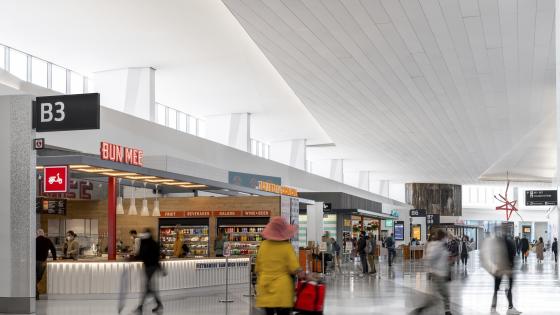
Natural light and high ceilings create a feeling of spaciousness for San Francisco International visitors
These concerns are also reflected in industry recommendations in the Americas from groups such as the Occupational Safety and Health Administration (OSHA); the American Society of Heating, Refrigerating and Air-Conditioning Engineers (ASHRAE); the American National Standards Institute (ANSI); and others.
Airports Council International (ACI) introduced its Airport Health Accreditation (AHA) programme during the pandemic, with more than 400 airports signing up. The organisation recently announced that the programme is to align its health measures with ICAO Council Aviation Recovery Task Force (CART) recommendations, and is transitioning to Public Health and Safety Readiness (PHSR) accreditation, which “considers a broader range of health events for the safety of passengers and airport staff.”
The organisation added: “It is imperative that airports incorporate adequate and efficient health disruptive event management into their business continuity and emergency response plans, to protect their passengers and staff as well as to reduce the risk of business losses.”
However, ongoing caution surrounding the presence of COVID-19 has not prevented air travel from returning to near-normal levels. ACI reported world airport traffic numbers at 6.6.billion in 2022, increasing 43.8% since 2021. And earlier this year, even with record high passenger numbers, pilot shortages and other issues, the JD Power 2023 North America Airport Satisfaction Study reported a significant increase in air travel – it seems people are happy to travel if they take precautions, and if they know the airport is addressing the welfare of those in and around it.
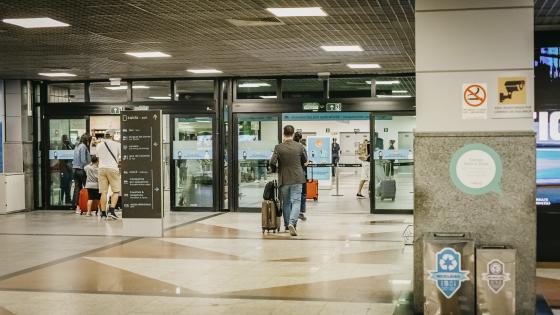
Staff need to take care when emptying bins, to avoid spillages
Crucially, the JD Power study revealed that satisfied travellers are more likely to spend money at airports, offering a direct correlation, which Raphael Sperry, associate principal at Arup, based in its San Francisco office, believes is the main reason for airports upping their game. “Happy passengers tend to spend more money, and I think this was true, driving improvements to increase wellbeing, before the pandemic,” he told Airports International. “It’s a top-shelf issue for airport executives.
“San Francisco International (SFO), which we work with, renovated the interiors of a terminal about ten years ago. They found that the revenue per square foot in that building was substantially higher than other terminals. And on the staffing side, airports found that if workers are happy, staff retention is more effective. We’re seeing more effort going into the back of house now, to help staff feel more valued and able to do their jobs.”
Rodrigo Fonseca, health and safety co-ordinator, Salvador Bahia Airport, cites the pandemic, staff retention and industry guidance as his combined list of reasons for the changes in his place of work. “The airport is a convergence point for people from all over the world,” he said. “So the exposure of passengers and workers to viruses is a concern, but we have a Pre-Hospital Care Post (PAPH) that operates 24/7, and a medical team and protocols in place, and we’re always attentive to the information and regulations from ICAO, the National Civil Aviation Agency of Brazil (ANAC) and the Brazilian Health Regulatory Agency (ANVISA), which conducts regular inspections, in addition to our own internal audits. We’re also concerned with the mental health of our staff, as it can impact operational safety.”
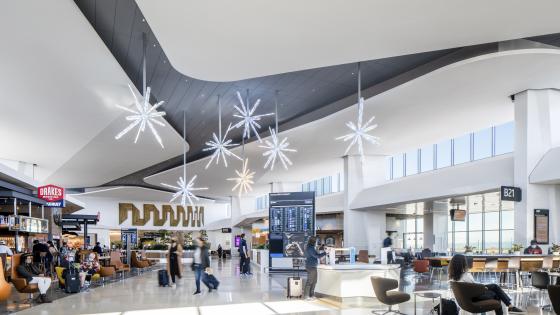
Giving passengers the space they need can help drive down stress levels
Air quality and noise
In addition to fighting the potential spread of diseases and viruses, airports are trying to mitigate the health risks posed by their everyday operations, particularly the noise and air pollution from aircraft, ground operations and outdoor road traffic. “You’ll have emissions from aircraft and ground vehicles, with airports most likely approached by a major highway,” said Arup’s Raphael Sperry. “That can hugely affect air quality, so some kind of filter system is needed. But it differs from airport to airport, as you need to identify what exactly needs filtering and the particle sizes.
“We carry out a detailed assessment first for the air handling systems we design – SFO has a LEED rating of platinum, which is the highest an airport can achieve, and reflects really good air quality. And to help achieve that, you want to choose the right interior-finish materials, such as carpets, paints and ceiling tiles that are air quality-tested and non-emitting, to protect theair inside.”
Regulations that give guidance on sustainability measures can also influence the wellbeing of passengers, with electric vehicles on site leading to lower carbon emissions and better air quality, for example.
But even more innovative measures are being taken across the US: Louisville Muhammad Ali International Airport (SDF), for instance, found that the air quality of its Jerry E Abramson Terminal improved as a result of its installing the largest geothermal system of any airport in the country, using the earth’s natural temperature for heating and cooling. Added as part of its sustainability efforts, increasing efficiency and reducing carbon emissions and energy use, the HVAC system contributed to a healthier environment for travellers and airport staff.
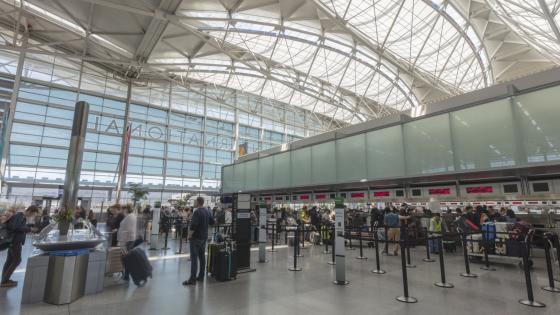
Circulation of clean air is essential for travellers and airport staff
“This project demonstrates how innovation can improve the quality of life both for travellers utilising this facility and for the community that surrounds it,” said Dan Mann, executive director at the airport. “Because of this, we’re able to provide a healthier, more comfortable environment inside the terminal.”
Keeping it clean
AECOM’s Boss warns of risks posed by recirculated air inside the airport, as this can spread diseases. “Emptying trash can be an issue, and it’s essential for staff to be mindful of spillages or aerosolization during disposal, especially where people are sitting or eating,” she said. “The same applies to vacuuming and dry-sweeping in close proximity to customers, as aerosolizing means that particulates can swirl at the vacuum inlet, and may include viruses, bacteria with endospores, and chemicals absorbed into the particulate.
“Clean bathrooms, with working soap and water dispensers, and automatic, non-touch functionalities, are important too. But just as not enough cleaning agents can create risk, so can using too many or the wrong kind. Chemicals can be hazardous to those actively using them, or as residuals on surfaces. Training on the safest and most effective chemical use can help.”
Salvador Bahia Airport’s Rodrigo Fonseca explains that his Maintenance, Operation and Control Plan (PMOC) considers the entire airport air conditioning system, with the Risk Management Program (PGR) helping to monitor noise and other concerns: “Also, the cleaning products used are biodegradable, in concentrations that do not affect a person’s health,” he said. “We even have a specific product dilution centre in a dedicated area, operated by trained personnel.”
Noise is another area that concerns AECOM’s Martha Boss. “Sustained noise above 85dB on the A-scale can damage hearing, and jet engines certainly exceed that, potentially impacting ground operations through distraction,” she told Airports International.
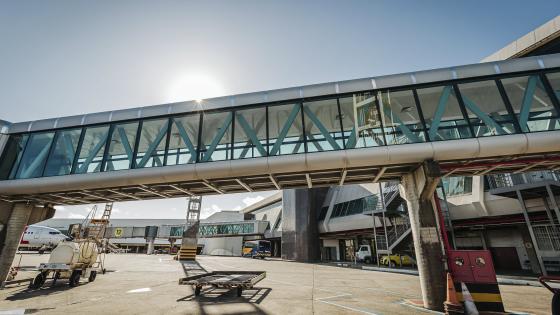
Noise and pollution can cause problems for ground support staff
Other measures
As airports continue to try to improve their environments for those inhabiting them, they may look to less obvious ways of increasing comfort. “Something we introduced at SFO Terminal 1 was electrochromic glass for the perimeter wall glazing,” said Arup’s Raphael Sperry. “People will often find they use airports very early in the morning, when the sun angle is low, and the glare can be quite intense, so having glass that tints to block that can be really helpful. At other times of the day, you may find you get a pool of hot sunshine that can make people uncomfortable, but tinting the glass allows the space to stay cool, so it’s okay to sit by a window and enjoy the view.
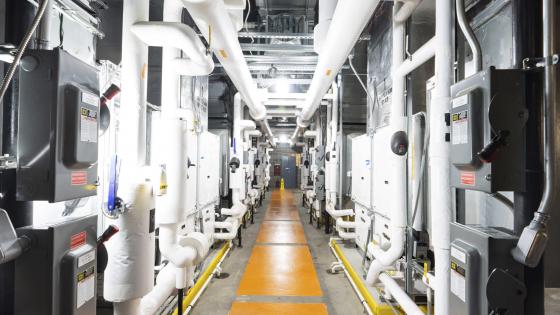
Geothermal water source heat pumps
“Something else we’re thinking about is the acoustics of the airport terminal. Even if you can block the engine noise from outside, it can still get loud inside, because airports tend to be really large rooms without acoustic separation. So, you want to try to control that noise and not make it unbearable, which includes the intelligibility of the PA system and the reverberation from interior surfaces. A poor acoustic environment leads to lots of stress.”
The stress factor is one that concerns Salvador Bahia Airport’s Rodrigo Fonseca. “Service quality, delays, cancellations, all of those kinds of things can cause stress,” he said. “Our airport is committed to ensuring the best levels of service quality, and was recently named the most punctual airport in the world in its category in July 2023, according to Cirium’s assessment. Measures to ensure service quality and availability, such as dining options, entertainment and child-friendly spaces, can all reduce stress.”
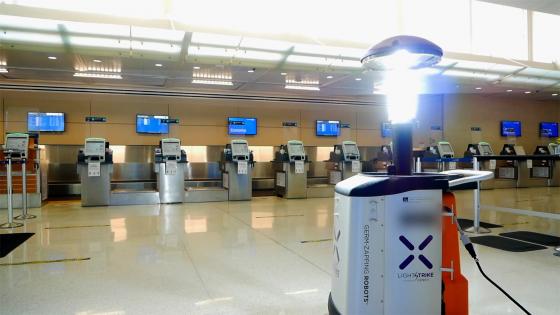
The Xenex LightStrike robot uses ultraviolet light to kill bacteria and viruses
What’s next?
With airports introducing measures to make passengers and staff more comfortable, there must be ideas in the works to take this to even higher levels, with everything from technology to architecture used in exciting and creative ways. Salvador Bahia Airport’s Fonseca agrees: “Technology to enhance acoustic comfort, and architectural concepts that improve the user experience, will increasingly become a reality in airport routines,” he explained. “Supporting physical and mental health through increasingly robust and mature processes, challenging us creatively to find solutions that promote a safe and healthy environment for our people and customers, will be a priority.”
Some in the industry are looking for new solutions already. “I can see biophilia – which means a love of nature – bringing natural designs and plants into the airport environment more extensively,” said Arup’s Raphael Sperry. “Even the terminal building itself might involve more natural materials, to give the feeling of a healthier environment, while supporting sustainability, and the whole idea that having people connect back to nature reduces stress.”
It sounds not unlike measures taken at airports elsewhere in the world, such as Helsinki-Vantaa International Airport in Finland, where open greenery greets passengers on landing, with the sounds of birds chirping played instead of music in washrooms. “Soundscapes are another area that could take off,” Sperry continued. “Inspired by nature, but also played at a particular frequency, designed to soothe and calm. These are ideas already being talked about.”
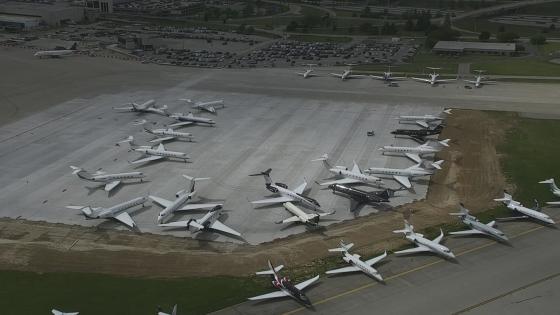
Aircraft parked on the new ramp above the geothermal wellfield during the 2023 Kentucky Derby
And how about some robotics to improve sanitation? In September 2020, San Antonio International Airport became the first in the world to employ the Xenex LightStrike robot, which uses an intense ultraviolet light to kill bacteria and viruses, helpful in hard-to-reach areas. The robot can cover gates, baggage claim and restrooms in just ten to 15 minutes, without warm-up or cool-down, and could prove popular in other locations.
Measures like these also reduce stress – something passengers will forever be dealing with at airports. How can processes become more streamlined, less crowded and faster? Perhaps there will be new ways to keep passengers updated and informed, or make appointments for check-in or passage through security. Self-service technology, predictive analysis, artificial intelligence, real-time information and data sharing could all be leveraged in the quest for seamless travel.
“And just more space to prevent overcrowding,” said AECOM’s Martha Boss. “This would allow adequate personal distancing too, mitigating against health risks. Big spaces that are clean must be considered in future airport design.”
It all contributes towards making a happier, healthier environment for those working in and passing through the airport. For revenues to continue to increase, traffic to grow, staff to be retained and reputations to remain intact, a proactive approach to these environments is essential. If all goes to plan, the airport could be as exciting and satisfying a destination as the one waiting when you finally land.
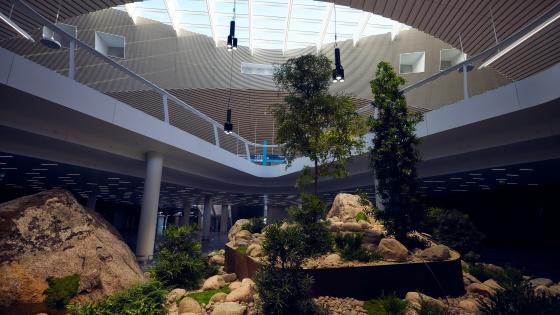
Greenery greets travellers landing at Helsinki-Vantaa International Airport
Further reading: the medical perspective
Dr Khalid Shukri is a physician certified by the American Board of Medical Specialities (ABMS) in anti-ageing and regenerative medicine, and a fellow of functional and metabolic medicine from the American Academy of Anti-Ageing Medicine. He now works at Wellth, an integrative medicine clinic in Dubai, managed by Medcare, a leading operator of UAE hospitals.
Dr Shukri explained the common health risks associated with airports: “Today’s high traffic at airports can play a key role in the international spread of diseases through people, conveyances and goods,” he said. “An example would be ‘airport malaria’, which occurs when mosquitoes infected with Plasmodium falciparum [the parasite causing the most severe kind of malaria], originating from countries with high transmission rates, contaminate airports elsewhere.
“Then you have jet engine emissions, with physicochemical properties similar to diesel exhaust particles, causing respiratory tract sensory irritation, increased pulmonary resistance and decreased weight gain. And aircraft noise, also emanating from ground traffic, can be considerable, particularly for ground handling and engine testing staff, leading to risk of hearing impairment.”

Dr Shukri of Wellth, an integrative medicine clinic in Dubai managed by Medcare
Does Dr Shukri therefore approve of airports mitigating these problems? “Yes, a more human-centric approach to the infrastructure, operations and environment of airports would be beneficial,” he told Airports International. “Electric vehicles used in ground operations would lower carbon emissions, while reducing light pollution and adopting air quality monitoring are not only better for people but can strengthen an airport’s sustainability credentials. Sanitation is also important to prevent the spread of diseases.”
However, ramping up cleaning and hygiene protocols too much can present a risk in itself. “Disinfectants are classified as pesticides by the US Environmental Protection Agency, as they are designed to kill not only pathogens but other living things as well,” he said. “Their use, or overuse, can prove harmful.”
And, of course, be wary of stress at all times: “Delays and overcrowding can lead to being uncomfortable, and you might also have limited access to amenities, such as food, which can increase stress,” Dr Shukri warned. “People with underlying mental health issues may experience heightened anxiety or paranoia during delays.”
